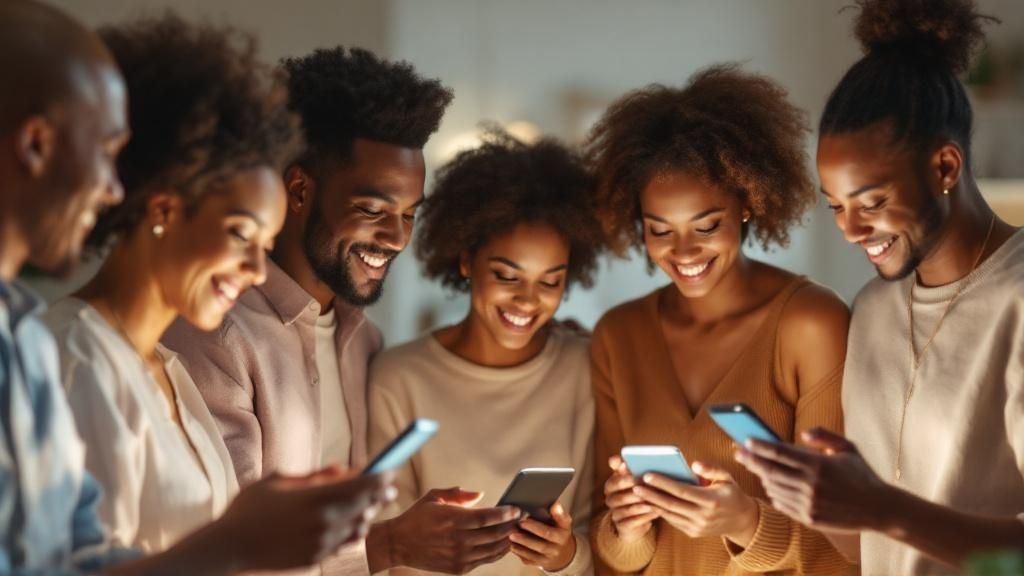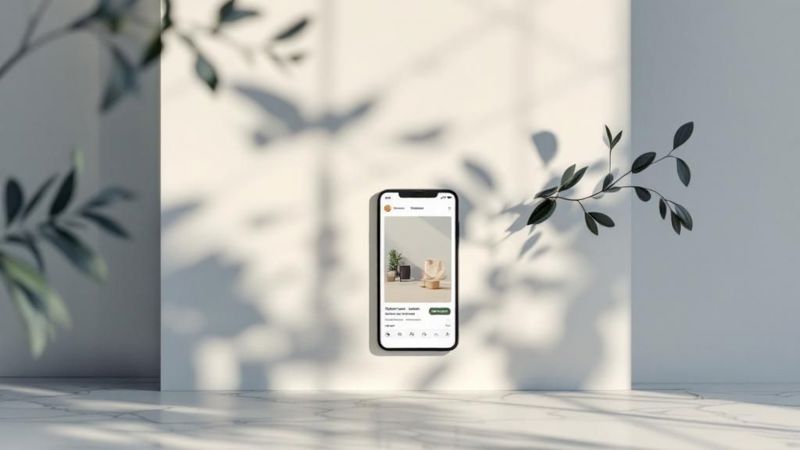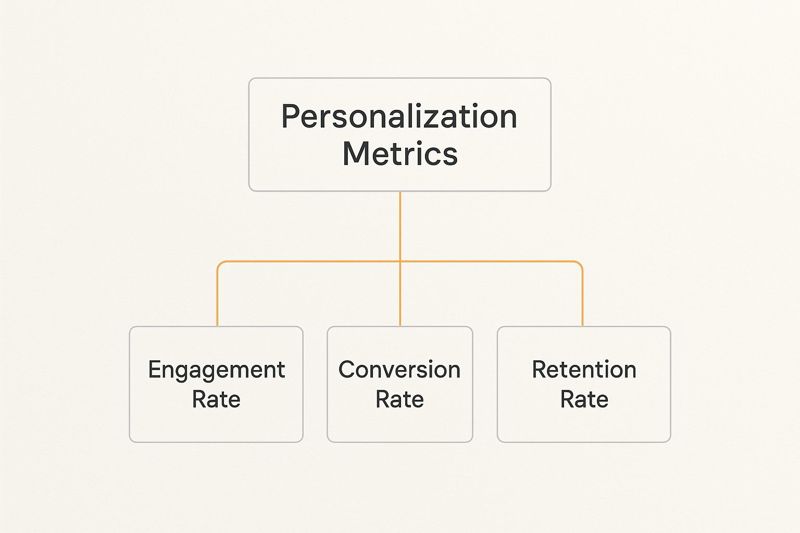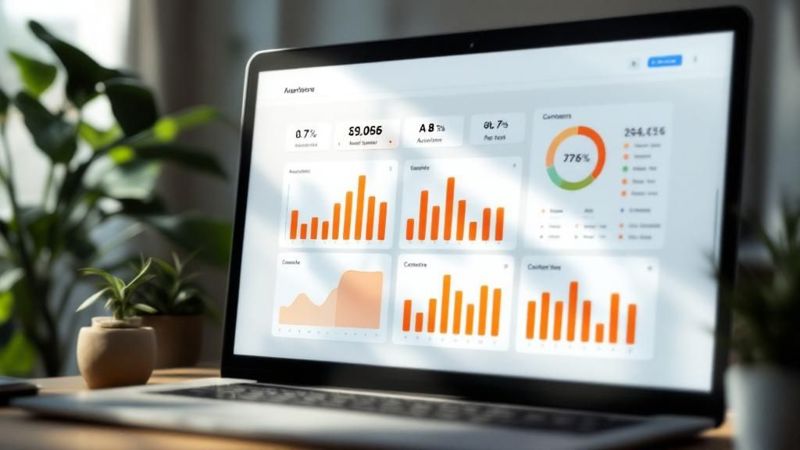Personalization in marketing is all about using what you know about your customers to create experiences that feel like they were made just for them. Think about your favorite local coffee shop where the barista knows your name and your go-to order. It’s that same feeling of being seen and understood—just delivered at a much larger scale.
What Is Personalization in Marketing Anyway?

At its heart, personalization is the complete opposite of the old-school "one-size-fits-all" approach. Instead of blasting out the same generic message to your entire audience, you’re creating a genuine one-to-one conversation between your brand and each individual. This is all made possible by using technology to analyze customer data and serve up content that’s actually relevant.
This isn’t just a passing trend; it's a fundamental shift in how successful brands connect with people. It’s become an expectation. In fact, companies that nail personalization generate 40% more revenue than those that don't, which shows just how much it can impact the bottom line.
To get a clearer picture, let's quickly break down the core ideas behind personalization.
Personalization at a Glance
This table offers a quick summary of what marketing personalization is all about.
| Core Question | Quick Answer |
|---|---|
| What is it? | Using customer data to create unique, relevant experiences for each person. |
| Why does it matter? | It builds stronger relationships, boosts engagement, and drives sales. |
| How does it work? | By analyzing user behavior, preferences, and demographics to tailor content. |
| What's the goal? | To make every customer feel understood and valued by the brand. |
As you can see, the focus is squarely on the individual, not the masses.
From Mass Marketing to Individual Conversations
Making the switch from traditional mass marketing to personalized communication involves a few key changes in mindset and strategy:
- Data-Driven Decisions: Every action is informed by real data—user behavior, preferences, and demographics—not just broad assumptions.
- Focus on Relevance: The goal is to deliver the right message to the right person at the right time. This makes your marketing feel helpful, not intrusive.
- Building Relationships: Personalization is all about building long-term loyalty by showing customers you get their individual needs and where they are in their journey.
Personalization is about more than just slotting a name into an email template; it’s about creating an experience that feels intentionally designed for one person. It's the difference between being spoken at and being spoken to.
Once you grasp this core concept, it’s easy to see why it’s a non-negotiable part of any modern marketing plan. It’s about making every single customer feel valued, which is what ultimately drives engagement, loyalty, and sales.
The Real-World Benefits of a Personalization Strategy

Putting a personalization strategy in place is about more than just giving customers a warm, fuzzy feeling. It’s a direct driver of business growth with results you can actually measure. When you make customers feel uniquely seen and understood, you're building a foundation for some powerful, tangible outcomes.
This is how you turn one-time buyers into loyal fans. When customers get relevant product recommendations or timely offers that genuinely fit what they need, they’re far more likely to come back. That translates directly into better customer loyalty and a higher lifetime value for every single person you connect with.
Boosting Revenue and Engagement
Done right, a personalization strategy is one of the most effective ways to lift your revenue. Companies that really nail true 1:1 personalization can bring in 40% more revenue than competitors still using generic, one-size-fits-all messaging.
How do they do it? By pulling together different data points—like website behavior and purchase history—to create a complete picture of the customer.
The financial boost comes from a few key areas:
- Higher Average Order Value (AOV): Smart, data-driven suggestions encourage people to add more relevant items to their carts. It just makes sense to them.
- Increased Conversion Rates: When you show people exactly what they’re looking for, you remove the friction from the buying process.
- Improved Customer Retention: A personalized experience makes customers feel valued, giving them a compelling reason to stick with your brand.
Personalization cuts through the digital noise. Instead of seeing another generic ad, the customer gets a solution, a recommendation, or an idea that feels like it was made just for them. That makes them far more likely to actually engage.
Ultimately, treating each customer like an individual creates a positive feedback loop. Better engagement leads to more sales, and more sales give you more data for even better personalization. For a deeper dive into these concepts, check out our complete guide on marketing personalisation strategies. This cycle is the engine that powers sustainable growth.
Understanding Different Types of Marketing Personalization
Personalization in marketing isn't just one thing—it's a whole spectrum of different approaches. Figuring out which type to use is key to hitting your goals. Think of them as building blocks, starting with broad segments and getting more and more specific to each individual.
From Broad Strokes to Real-Time Relevance
The most straightforward starting point is demographic personalization. This is about using basic, observable data—things like a person's age, gender, or job title—to tailor your content. A classic example is a clothing store showing different ads to men than to women. It’s a solid foundation, but it's just the first layer.
Then you have contextual personalization, which is all about what’s happening right now. This approach adapts the user experience based on real-time situational data. It could be an e-commerce site showing you winter coats because you’re browsing from a cold climate. Or maybe a travel app pointing out nearby attractions based on your current location.
It's powerful because it's immediately relevant to what the user is doing in that exact moment.
The infographic below shows what these efforts are really aiming for.

As you can see, the end game is always about boosting engagement and conversions by making the entire customer journey feel more relevant.
Getting Smarter with Behavioral Cues
Finally, we arrive at behavioral personalization, which is the most dynamic and sophisticated of the bunch. This method uses a customer's past actions—like pages they've viewed, products they've clicked on, or their purchase history—to predict what they'll want next.
A perfect example is a streaming service that recommends a new show based on what you’ve already watched. It’s analyzing your past behavior to make a smart guess about what you'll enjoy, creating a sticky experience that keeps you coming back.
To give you a better sense of how these types compare, here's a quick breakdown.
Types of Personalization Explained
| Personalization Type | Data Source | Example in Action |
|---|---|---|
| Demographic | Basic user data like age, gender, location, job title. | A B2B software company shows an ad for its enterprise plan to users with a "Manager" or "Director" job title. |
| Contextual | Real-time information like device type, time of day, weather, or current location. | A food delivery app promotes ice cream on a hot day or hot soup when it’s cold and rainy. |
| Behavioral | Past user actions like pages visited, items added to cart, purchase history, or videos watched. | An online retailer sends a follow-up email with a discount for a product a user viewed but didn't buy. |
This more advanced approach requires more data, but the payoff is a truly customized interaction. For instance, when you learn how to send personalized emails for event registration, you're often tapping into behavioral cues like past attendance to make the invitation feel exclusive.
By mixing and matching these different types, you can build a complete personalization strategy that makes every single customer feel like you know them personally.
How AI and Technology Power Modern Personalization

Delivering a truly unique experience to millions of people at once sounds like a fantasy, right? But it’s happening every single day, and it's all thanks to technology. Artificial Intelligence (AI) and machine learning are the engines turning mountains of raw data into meaningful, one-to-one conversations.
Think of it like having a digital assistant who knows your customers better than they know themselves. These systems sift through everything—from browsing history and past purchases to the time of day someone is most active—to spot hidden patterns and predict what they'll do next. They anticipate a customer's need before they even think to search for it.
Behind the curtain, a few key pieces of tech work together to make this magic happen.
The Tech Behind the Scenes
The modern personalization stack isn't just one tool; it's a team of specialized platforms working in concert.
Customer Data Platforms (CDPs): This is the central hub. A CDP gathers data from every touchpoint—your website, app, social media, in-store purchases—and stitches it all together into a single, unified profile for each customer. No more siloed information.
AI and Machine Learning Engines: This is the brain of the operation. It analyzes all the data collected by the CDP to power things like the dynamic product recommendations you see on Amazon or the "what to watch next" suggestions on Netflix.
Automation Tools: These are the hands that execute the plan. Based on the AI's insights, these platforms send that perfectly timed email, display a super-relevant ad, or trigger a specific website experience.
When these technologies are integrated, the results are powerful. One North American retailer connected its existing systems with modern marketing tech and saw a staggering $400 million lift from better pricing and an extra $150 million from AI-powered offers—in just one year.
By automating data analysis and decision-making, technology frees up marketers to focus on strategy and creativity. Personalization stops being a manual chore and becomes a powerful, automated engine for growth.
To really get ahead, smart marketers are also using advanced tools like predictive analytics for marketing to forecast customer actions before they happen. This technology even extends to the visuals themselves. You can dive into the power of dynamic images in your email strategy and learn how to create visuals that literally change for every single recipient.
Building a Personalization Strategy That Works
A great personalization strategy doesn't just happen; you build it with intention. The first step is to get crystal clear on your goals. Are you trying to bump up conversions? Build rock-solid customer loyalty? Maybe you need to stop customers from churning. Whatever it is, knowing your "why" from the get-go keeps every effort pointed in the right direction.
Next up, you need a solid data foundation. This means collecting the right customer information, but it has to be done ethically and with total transparency. Privacy is non-negotiable here. Trust is the real currency of personalization, and people will only share their data if they believe you'll use it responsibly to make their experience better.
As you build out your plan, think about how you can use effective marketing automation strategies to handle the heavy lifting and deliver those tailored experiences at scale.
From Data to Delight
Once your data is in place, the real work begins. You'll need to dig in and analyze it to uncover the kinds of insights that actually drive smart personalization. From there, you can start creating targeted segments and crafting messages that truly speak to each group.
But don't just set it and forget it.
- A/B Test Everything: Always be testing your personalized elements. From email subject lines to the product recommendations you show, you need to find out what truly connects with your audience.
- Start Small and Scale: You don't have to personalize every single touchpoint overnight. Pick a few high-impact areas to start with, learn what works, and then expand from there.
- Avoid Being Invasive: The goal is to be helpful, not creepy. Use data to provide real value—like offering a relevant discount—rather than just showing off how much you know.
Today's customers don't just appreciate personalization; they expect it. By 2025, it's a core demand, with 76% of consumers more likely to buy and 78% more likely to come back to brands that personalize their experience.
This shift isn’t just on the consumer side. A staggering 90% of marketers believe personalization is a major boost to their profitability. This shows a clear link between what customers want and what drives business success, which you can see by exploring more personalization statistics and insights. When you build a strategy that’s both effective and ethical, you create connections that feel right to your customers for all the right reasons.
Putting Personalization into Action with Dynamic Imagery
So, how do we move from theory to actually doing this? One of the most powerful ways to bring personalization to life is with dynamic imagery.
Let's be honest, we've all become experts at ignoring generic, one-size-fits-all images. But imagine getting an email where the main banner has your name on it. Or seeing a social media ad that shows the exact product you were just looking at.
That kind of detail grabs your attention instantly. Tools like OKZest make this incredibly accessible, letting you build these hyper-relevant visuals without needing to write a single line of code. Think of it like adding merge tags directly into your images, making each one completely unique to the person seeing it.
Why Visuals Matter So Much
A personalized image creates a connection that text alone just can't replicate. It flips a generic marketing message into a personal conversation, which skyrockets engagement and makes your audience feel seen.
Just look at how different pieces of data can come together to generate a unique visual for every single person.
This example shows how simple details—names, dates, or specific products—can be slotted right into a single image template. By tapping into the right platforms and tools, you can put this kind of personalization to work. If you're using WordPress, for instance, learning about mastering Elementor dynamic content can be a great place to start.
Personalized advertising is up to 5X more valuable than just contextual advertising. When you combine both with dynamic visuals, the impact on engagement and conversions can be significant.
When you create these tailored visual experiences, you're not just sending a message that gets noticed. You're delivering something that feels genuinely relevant to each person.
Common Questions About Marketing Personalization
As you start digging into personalization, a few questions always seem to pop up. Let's clear the air and tackle them head-on so you can move forward with confidence.
Personalization vs. Customization
You’ll hear these two terms thrown around a lot, often used to mean the same thing. But there's a key difference, and it comes down to who’s doing the work.
Personalization is what a company does for a user. It’s all about using data to guess what someone might want or need. Think about Netflix serving up a show it thinks you'll love based on what you've already watched. You didn't ask for it, but it feels right.
Customization, on the other hand, is what a user does for themselves. It's about giving people the power to tweak their own experience, like switching an app to dark mode or choosing the topics they want to see in their news feed. Both get you to a more relevant experience, just from opposite directions.
Is Personalization Creepy?
This is a big one. And it’s a fair question. Personalization definitely crosses a line when it stops feeling helpful and starts feeling intrusive. The trick is to always focus on delivering real value and being upfront about how you're using data.
Good personalization feels like a helpful assistant who knows what you need before you ask. Bad personalization feels like a stalker who knows too much.
When customers see it as a fair trade—their data for a better, easier experience—they're almost always on board.
Can Small Businesses Use Personalization?
Absolutely. You don't need a massive marketing budget or a team of data scientists to get started. Small businesses can get huge results from a few simple, smart tactics.
Start with the basics:
- Use a customer's first name in your email subject lines.
- Segment your audience based on past purchases to send them offers they'll actually care about.
- Recommend products that complement something they've already bought.
The key is to start small, see what works, and build from there.
Ready to make your marketing visuals feel personal? OKZest helps you create thousands of unique, dynamic images for emails, social media, and more—no code required. Automate your personalized images today at OKZest.com.